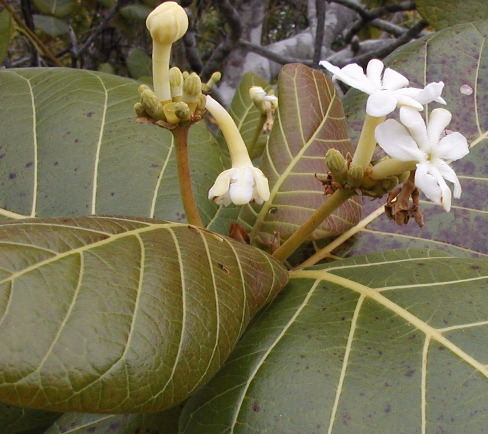- Guettarda speciosa
Taxobox
name = "Guettarda speciosa"

image_caption = "Guettarda speciosa"
regnum =Plant ae
divisio =Magnoliophyta
classis =Magnoliopsida
subclassis =Asteridae
unranked_ordo =Euasterids I
ordo =Gentianales
familia =Rubiaceae
subfamilia =Cinchonoideae
tribus =Guettardeae
genus = "Guettarda "
species = "G. speciosa"
binomial = "Guettarda speciosa"
binomial_authority = L."Guettarda speciosa", colloquially called beach gardenia, or zebra wood, is a species of
shrub in the familyRubiaceae found in coastal habitats in tropical areas around the Pacific Ocean, including the coastline of central and northern Queensland and Northern Territory in Australia, and Pacific Islands, including Micronesia, French Polynesia and Fiji, Malaysia and Indonesia and the east coast of Africa. It reaches 6 m in height, has fragrant white flowers, and large green prominently-veined leaves. It grows in sand above the high tide mark.Taxonomy and naming
Alternate names in the Cook Islands include "‘Ano", "Hano", "Fano", and "Puapua". The last is also used in Samoa, and the similar "Puopua" in Tonga.cite web |author=McCormack G |url=http://cookislands.bishopmuseum.org/species.asp?id=6192 |title=Guettarda speciosa |work=Bishop Museum: Cook Islands Biodiversity Database|accessdate=2008-06-01 |publisher=Bishop Museum |date=2007] It is known as "Utilomar" in the
Marshall Islands .It was originally described by Linnaeus. The genus was named in honour of the 18th century French naturalist
Jean-Étienne Guettard , while the specific epithet is derived from theLatin "speciosus" 'showy'. [cite book|author = Simpson DP| title = Cassell's Latin Dictionary | publisher = Cassell Ltd.| date = 1979|edition = 5|location = London|pages = 883| isbn=0-304-52257-0]Description
It is a perennial shrub or small tree 2-6 m (7-20 ft) tall by 1-3 m (3-10 ft) wide with smooth creamy grey bark. The large oval-shaped leaves are 15-23 cm (6-9 in) long by 10-18 cm (4-7 in) wide. Dark green and smooth above with prominent paler veins, they are finely hairy underneath. Flowering is from October to May, the fragrant white flowers are 2.5-3 cm (1-1½ in) long with 4-9 lobes. These are followed by sweet-smelling globular hard fruit, measuring 2.5-2.8 x 2.2-2.5 cm (1 x 1 in), which mature September to March.cite book |author=Eliot RW, Jones DL, Blake T |title=Encyclopaedia of Australian Plants Suitable for Cultivation: Vol. 5|year=1990|pages=p. 162 |publisher=Lothian Press |location=Port Melbourne |isbn=0-85091-285-7] cite book |title=Native plants of northern Australia |last=Brock |first=John|year=2001 |publisher=New Holland Press |location=Sydney |isbn=1-876334-67-3 |pages=p. 211]
Distribution and habitat
"Guettarda speciosa" is found in coastal habitats in tropical areas around the Pacific Ocean, including the coastline of central and northern Queensland and Northern Territory in Australia, and Pacific Islands, including Micronesia, French Polynesia and Fiji, Malaysia and Indonesia and the east coast of Africa.As its name suggests, the beach gardenia grows on beaches and sandy places above the high tide level.
Ecology
The
Mariana Fruit Bat "(Pteropus mariannus)" feeds on the fruit and flowers, acting as a vector for the dispersal of seeds.Human use
Use by indigenous cultures
The large leaves were used in various ways by the indigenous people of northern Australia; they could hold food, and when heated, they were given to relieve headaches and aches in limbs. The stems could be used to make Macassan pipes.cite book |title= Plants and People: Aboriginal Uses of Plants on Groote Eylandt |last=Levitt |first=Dulcie |year=1981 |publisher=Australian Institute of Aboriginal Studies |location=Canberra |isbn=0391022059] The flowers were used to scent coconut oil on the Cook Islands, and the wood for dwellings and canoes.
Cultivation
A very useful plant for seaside planting in tropical climates, it needs a sunny aspect and well-drained soil. It has proven difficult to propagate, as this must be done by seed which may take months to germinate.
References
Wikimedia Foundation. 2010.
